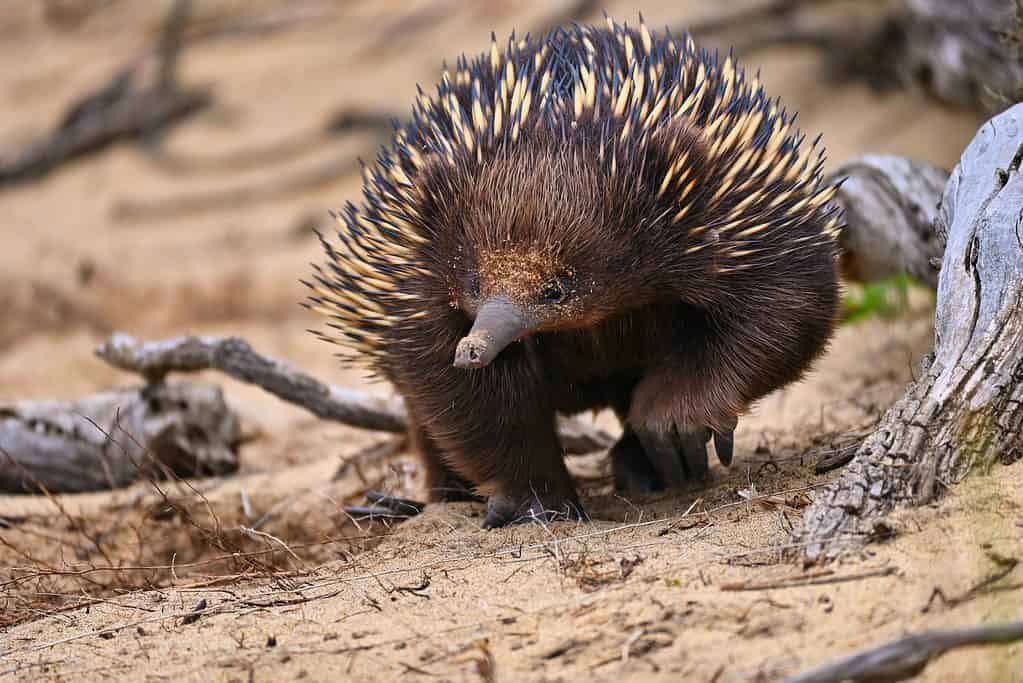A new year has just begun and Australia is already facing record-breaking heat waves. While most humans and animals in Australia are struggling to cope with the soaring heat, one particular species has figured out a stunning way to deal with the hot weather. We are talking about Australian echidnas, one of the most special animals on the face of the planet.
Echidnas are usually considered too weak to deal with the heat but as it turns out, these spike-balls are great at keeping themselves cool just by blowing snot bubbles and performing belly-flops.

On January 13, a scorching temperature of 50.7 °C (123.3 °F) was reported in Onslow, a town located in western Australia. This is equal to the highest-ever temperature recorded in the country, a record that dates from June 1960. While much of the coverage of this event focused on the effect the record heat has on humans, Australia is also home to over one million animal species, many of which are found nowhere else on the planet.
Such extreme weather conditions adversely affect the country’s rich biodiversity. Some previous studies have pointed out that temperatures above 35°C or 38°C would kill short-beaked echidnas (Tachyglossus aculeatus) in Australia. However, a team of researchers from Curtin University has recently discovered that this may not be true, and the echidna is impressively resilient.
“We observed echidnas active at maximum Tas (temperatures) that were 2.4°C higher than their supposed lethal Ta of 35°C and up to 5.4°C higher than the previously reported maximum active Ta. Our data, combined with observations that echidnas can shelter in hollow logs at temperatures up to 40°C, provide clear evidence that previous estimates of lethal Ta were underestimates and highlights the value of detailed field studies for evaluating the physiological capabilities of wild animals. Echidnas can clearly tolerate higher Ta and are less reliant on behavioral thermoregulation than previously appreciated,” the researchers note.
How do snot bubbles keep echidnas cool?
Humans, horses, apes, and many other animals keep themselves cool by sweating but echidnas lack sweat glands and therefore can’t sweat. Other animals like cats and kangaroos have a habit of licking their limbs and other body parts. The licking allows them to get rid of the excess heat from their body via evaporation. However, echidnas have spikes all over their body so licking is also not possible in their case.
So echidnas had to get creative, and the researchers at Curtin were curious how echidnas were able to do it.
“We have suspected for a long time that they’re much more tolerant than what the early lab data suggests. And that raises the question of how do they deal with these higher temperatures when they don’t pant or lick or sweat,” first author and a professor at Curtin, Dr. Christine Cooper told The Guardian.
To find out their secret, they observed echidnas in different temperature conditions under high-resolution heat vision cameras. During their study, they also monitored the water content and breathing rate of the animals.
The thermal cameras revealed that every time an echidna was moved to a high-temperature setting, mucus bubbles emerged from its nose. The bubble would soon burst and wet its snout, cooling the nose tip as the moisture from the bubble evaporated. The researchers assumed that echidnas were using snot bubbles to cool down themselves.
This assumption was further backed by the fact that echidnas maintain a highly-vascularized area right under their nose. After a snout bubble bursts, the resulting moisture starts to evaporate, drawing away the heat from the blood in the vessels in the echidna’s beak. Eventually, the animal’s blood cools down and so is its body. When the authors measured the temperature of the echidnas’ snouts in hot conditions, they were found to be very cold.
There is more than just snot bubbles
Dr. Cooper and her team discovered that most of the heat loss from an echidna’s body takes place from their beaks which become the coldest body part in these animals after the snout bubble bursts. However, the snot bubble is not the only thing that keeps echidnas cool. These monotremes also shed some of their body heat by flopping their spike-free bellies and legs against cold objects such as tree logs and wet surfaces.
The researchers will now conduct experiments to further understand the snot bubble mechanism in echidnas. They will test its effectiveness in different sunlight conditions for different durations, and will also try to find if this cooling mechanism has any limitations.
The study is published in the journal Biology Letters.









